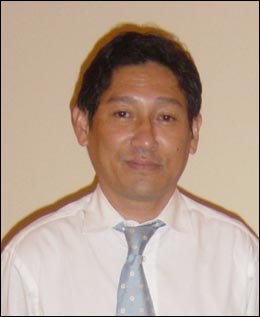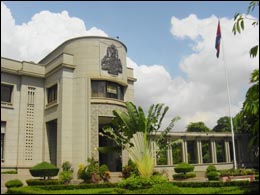 Openness
to foreign investment Openness
to foreign investment |

Significant gaps in the nation's legal and institutional
frameworks limit business confidence in Cambodia,
but there are opportunities for foreign exporters
and investors. The
Council for the Development of Cambodia (CDC)
Cambodia's foreign investment approval body,
administers an attractive package of investment
incentives and imposes few restrictions on imports
from abroad. The recent amendments made to the
investment law makes the procedure even easier
than before as
H.E. Sok Chenda Sophea, Secretary General of the
CDC (Link to the Company Profile) said: "with
the new law, the investor will come to the CDC,
present its project and apply to us (…).
The innovation lies in the role of the CDC to
secure, on behalf of investors, all necessary
permits, licenses and authorizations from other
ministries". The CDC has even pushed further
its performance and has lowered the length of
the process application. It used to be 45 working
days, but as H.E. Suon Sitthy, Deputy Secretary
General of the Cambodian Investment Board (CIB)
explains: "Following the new Investment Law,
the length of this process must not take longer
than 28 working days. When it comes to routine
cases like for instance a garment project, the
process takes even less time and it can be approved
within 7 working days".
Cambodia's 1994 law on investment (attach law
on investment.doc) establishes an open and liberal
foreign investment regime. All sectors of the
economy are open to foreign investment. There
are no performance requirements and no sectors
in which foreign investors are denied national
treatment with the exception of land ownership
(but a foreigner is able to lease land for a period
of up 70 years). "when it comes to do business
in Cambodia, foreigners have the same rights as
nationals; you can own and operate 100% any kind
of business" said H.E.
Sok Chenda Sophea. A successful example of
this policy is the Phnom Penh and Siem Reap airports
realized in partnership with the French company,
Vinci.
The Law on investment is supported by recent
revisions to the Law on taxation under which investors
can choose to be subject to a special depreciation
schedule rather than automatic three years tax
holiday provisions under the Law on investment.
For example, it provides tax and duty exemptions,
including those for projects located in Export
promotion Zones (EPZ).
Thanks to this policy, the Kingdom has already
attracted 1.1 billion USD. Even if there is a
decline in FDI, the existing investors have managed
to expand their projects, especially in the manufacturing
sector, in particular the textile industry. In
terms of major foreign investing nations, the
top three sources are Malaysia, Taiwan and the
United States of America.
 Future
challenges and opportunities Future
challenges and opportunities |
Cambodia is facing serious challenges in the
coming years. The Kingdom has seen a declining
trend in garment exports, due to the global economic
slowdown and US granting preferential trade arrangements
to other countries, including Vietnam. Moreover,
the phasing out for the quotas under the WTO Agreement
on Clothing and Textiles (ACT) in 2005 will mean
massive changes in the Cambodian garment industry.
Fundamentally, the abolition of quotas would leave
Cambodia without a guaranteed market for its garments
exports. Cambodia still suffers from poor infrastructure
and high utilities costs. While the "cheap,
productive workforce" approach will be used
to maintain and attract new foreign investments,
Cambodia will face great difficulties in competing
with large-scale producers such as India or China.
Moreover, attention should be paid to labor costs
in Cambodia in the next three years. Electricity
prices, transportation and port handling costs
in Cambodia, are high when compared to other countries
in Asia. But if given the proper attention to
infrastructure works, the opportunity for a steady
and sustainable growth can be achieved. Mr. L-Martin
Desautels, Managing Director of DFDL
Legal & Tax Advisors (www.dfdl.com.kh),
comments on the current opportunities in infrastructure:
"(…) roads, electricity, telecommunications,
water. That's the place where the biggest potential
is and there are some investors interested into
it. We have already some clients interested into
developing infrastructure. In my opinion, this
area will develop a lot in the next years. The
government is also making efforts to set up a
clear and transparent framework to attract investors
towards this kind of projects".
|
 Cambodia's
Competitive Advantage Cambodia's
Competitive Advantage |
Currently in the final phase of its accession
to WTO, Cambodia is reaching the last level of
its slow progress into the international arena.
"(…) with the upcoming membership to
the WTO, and the adoption of the intellectual
property law this year things are going to improve."
Said Mr. Desautels.
Indeed Cambodia's will to access to the main
international commercial organizations had made
these legal reforms a sine qua non condition.

Moreover the country received special status
through the GSP (Generalized System of Preferences)
and MFN (Most Favored Nation) schemes. Market
access wise, Cambodia is one of the two remaining
LDC's in the region (the other being Lao PDR)
still benefiting from the GSP scheme of major
developed trading partners like the US, EU, Canada,
Australia and Japan. There are altogether 28 countries
(trade partners) offering MFN/GSP privileges for
Cambodia exports.
 Growth
corridors, highways to regional integration Growth
corridors, highways to regional integration |
Cambodia economical development through regional
integration has been performed through its access
to the ASEAN organization and by ratifying the
CEPT (Common Effective Preferential Trade Area)
agreement, thus enjoying law tariff rates making
"Cambodia a viable base for exports to the
ASEAN zone".
With its integration into ASEAN, Cambodia benefits
from the combined population of the 10 ASEAN member
countries, which is about 500 million people.
The grouping, also rich in natural resources,
raw materials, and land, represents a large market
full of economic potential and an attractive destination
for investment. The combined GDP of the ASEAN-10
was about US$ 700 billion in 1996. The region
experienced high economic growth of 5% to 7% in
the 25 years before the financial crises in 1997.
This regional integration is also backed up by
the Greater Mekong Sub-region structure Program
which goal is to promote economic and social development
by strengthening economic linkages between its
members: Cambodia, Laos, Myanmar, Thailand, Vietnam
and Yunnan. The priority sectors are transport,
telecom, energy, environment, tourism, trade facilitation,
investment, and human resource development. According
to Hang Chuon Naron, from the Ministry of Economy
and Finance "All these investments and efforts
will transform, within the foreseeable future,
the Sub-regional economy into a broad, rapidly
growing market of close to 500 million people
who enjoy the benefits of prosperity and peace".
In order to attract manufacturers into Cambodia,
the government created Special Promotions Zones
and Special Processing Zones, which will according
to the Minister of Commerce
H.E. Cham Prasidh "maximize the potential
that we get from the special and differential
treatment we have from the developed countries"(Cambodia
as a LDC benefits of the 0% tariff rate) and thus
attract neighbours liable to MFN rate duty such
as Thailand and Vietnam, into these privileged
zones."
By setting up Export Processing Zones, next to
the Thai and Vietnamese borders the government
intends to obtain the relocation into Cambodia
of the closest Thai and Vietnamese factories,
the latter thus benefiting from Cambodia's export
documents.
"They may re-export their production from
the same port of Thailand and reach the same old
customer in Europe, but cheaper because it is
duty-free" adds the Minister
of Commerce "we are providing them a
very stream lined procedure in the Export Processing
Zone and one-stop service (…) we propose
all kind of incentives that we have provided in
our investment law". With Thailand, Cambodia
has also developed a "Crescent of Opportunities"
cooperation setting up strategies on promotion
of trade and investment, establishing thus the
concept of "two kingdoms, one destination".
In order to increase Cambodia's chance to access
to the WTO the government is tackling several
issues concerning trade liberalization policies
and mainstreaming trade strategy for national
development policies aimed at poverty reduction
in Cambodia.
Cambodia has also set out a legislative agenda
to implement the WTO requirements with various
intellectual property laws, competition law, insolvency,
law, law on business enterprises, commercial contracts
law, secured transaction law, law on rules of
origin and various laws on antidumping and countervailing
duties.
According to Mr. Bretton Sciaroni, one of the
MekongBank managing directors, "after decades
of isolation, Cambodia is joining the mainstream
of the regional and international economic system.
Discussion of ASEAN, AFTA, and WTO all will contribute
to the potential investors vision of Cambodia
as being on the path to normalization of its trade
and economic relations with other countries".
|

